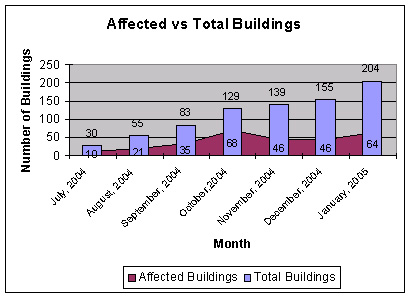|
The mold after the storm: A
Stachybotrys Survey in Central Florida
|
||
|
|
||
| By Dr. Blanca Cortes,
Microbiology Laboratory Director and General Manager EMSL Analytical,
Inc. Orlando, 5125 Adanson St. Suite 900, Orlando, Florida 32804 |
||
| Last year (2004), Florida
was faced with the worst hurricane season in a century, with four of the
six major hurricanes directly affecting Central Florida. Charley made
landfall on the southwest coast of Florida during the evening of August
13th with maximum sustained winds near 150 MPH. Charley was responsible
for over 6 billion dollars in property damages ranging from total
devastation, to blown off roofs, to water intrusion due to saturation.
Three weeks later, on September 5th, Frances battered Central Florida.
Ivan followed Frances making landfall on September 21st. Last but not
least, Jeanne entered near Stuart as a category three hurricane, six
days later, following the same path of Frances, three weeks earlier.
Needless to say, Mother Nature was moving into Central Florida faster
than were the adjusters, roofers and contractors hired to deal with
property damage. While leaks, humidity, and wind drafts were some of the
problems Central Florida residents had to endure, a major concern
plaguing the affected dwellings was mold proliferation. One can gauge
the degree of water damage in a building by the composition of the mold
spores found inside the affected building. There are three stages of
mold colonization, based on water activity requirements. Water activity
(Aw) is an expression of the relative water availability in a substance
and it measures the vapor pressure generated by the moisture present in
a hygroscopic product. The water activity of a product is one-hundredth
its equilibrium relative humidity. Low Aw (<0.85) favors primary
colonizers such as Aspergillus versicolor, Penicillium and Wallemia.
Secondary colonizers such as most Aspergillus species and Cladosporium
need intermediate levels of Aw (0.85-0.90), and fungi that require wet
conditions, thus high Aw (>0.90) are considered tertiary colonizers and
include Alternaria, Aspergillus fumigatus, Chaetomium, Fusarium,
Memnoniella, and Stachybotrys, among others. This study concentrates on
the proliferation of a genus associated with high water damage
conditions, Stachybotrys. |
||
|
||
| Air trap samples from 591 buildings were examined from July 2004 to January 2005. During that period of time, Stachybotrys and/or Memnoniella (Stachybotrys echinata) affected 226 buildings out of the 591 examined (Figure 1). Individual levels of contamination ranged from 21 spores/cubic meters to 87,900 spores/cubic meter. Monthly concentrations ranged from 1055 spores/cubic meter to 201,224 spores/cubic meter (Figure 2). Andersen agar plate impactor samples corroborated Stachybotrys proliferation, with levels ranging from 700 colony forming units (CFU's)/cubic meter to over 350,000 CFU's/cubic meter. The peak incidence was observed during the month of October where Stachybotrys affected 52.71% of the buildings examined. Total concentrations for October were 19,190 spores/cubic meter for Stachybotrys and 141,921 spores/cubic meter for Memnoniella. A gradual decrease was observed in the number of affected buildings during November (33%), December (29%) and January (31%). However, while the number of affected buildings was decreasing, mold amplification was on the rise. December concentrations went from approximated 161,00 to approximately 208,000 spores/cubic meter. | ||
 Water intrusion due to roofless housing, water damage due to prolonged
floods, and the characteristic heat and humidity of Florida can be
factors enhancing mold amplification. Now that winter is here, and the
heat and the humidity are lower, freezing temperatures in central
Florida are forcing dwellers to use heating devices to keep warm. Once
again the combination of heat and humidity can be a cause of mold
amplification, as evidenced by an increase in the number of affected
buildings in January 2005 over December 2004. To compound the problem,
many houses still have only a blue tarp for roofing, and these tarps are
beginning to deteriorate. Rainfall associated with frontal systems
continues to pound unprotected homes. We will continue to monitor
Central Florida's mold problem as we approach a new season…
Water intrusion due to roofless housing, water damage due to prolonged
floods, and the characteristic heat and humidity of Florida can be
factors enhancing mold amplification. Now that winter is here, and the
heat and the humidity are lower, freezing temperatures in central
Florida are forcing dwellers to use heating devices to keep warm. Once
again the combination of heat and humidity can be a cause of mold
amplification, as evidenced by an increase in the number of affected
buildings in January 2005 over December 2004. To compound the problem,
many houses still have only a blue tarp for roofing, and these tarps are
beginning to deteriorate. Rainfall associated with frontal systems
continues to pound unprotected homes. We will continue to monitor
Central Florida's mold problem as we approach a new season… |
